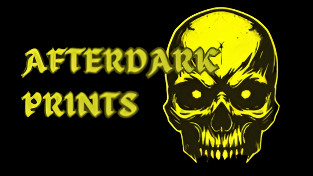Hello, and welcome to an AfterDark resource page! Our goal with this post is to explain supports, and provide assistance with removing them. We'll include advice, pictures, and video to explain.
Topics within this article, if you're looking for a specific section, click the link to jump to it:
I prefer text guides, but if you're a visual learner, we also wanted to create something for you as well!
What are 3D printing supports?
While 3D printing unlocks amazing potential for small scale reproduction of almost anything, one component of the manufacturing process is supports. These are extra printed parts that connect with the model to ensure that everything prints correctly, and reliably.
Supports usually come in the form of a network of individual, slim columns of plastic. They may connect between 2 parts of a model, or at the very first layer of the print. Most models are lifted and rotated from the build plate to ensure even the smallest details at the base of a model (feet, ground floor of a building) are reproduced exactly as intended rather than starting from the surface of the printer build plate.

Each individual support will reach up and connect back to the model. This may result in what looks like a forest of extra plastic, but each contact point with the model is incredibly minimal. This is by design as the supports should cleanly snap away from the model while leaving behind none or very minimal excess material - a massive improvement over flashing from injection molding!
What do they do?
While they may seem like a hassle, we take great care to ensure they are well utilized. Many creators release pre-supported models that make printing simpler, but don't always match our expectations of reliability. We review all models for supports before we put them into production.
Supports connect between overhangs that would otherwise be impossible to print from ground up. Think about an arm positioned away from the body - if it suddenly comes into play halfway, there's nothing to attach it to the rest of the print. Supports are placed to ensure there's a solid structure so that when you get to the elbow and shoulder, it seamlessly connects to the torso and is positioned exactly as it should be.
What are the benefits?
A huge benefit is that models designed for 3D printing are often fully (or mostly) assembled rather than being a box of arms, legs, weapons, heads, hair, etc. that you need to cut out and glue together while worrying about gaps between parts.
As we sell online to customers anywhere in the world, shipping is a huge factor we have to consider. Supports not only make complex prints possible, but add a ton of structure and support. Despite our best attempts at packaging with care, shipping providers tend to be rough on their cargo. Imagine a detailed miniature with a complex spear - would you rather it arrive completely in tact and require a few moments to clean up, or risk the near inevitably it breaks in shipping and needs to be glued on... if you don't lose it in the packaging!
How are they removed?
Removing supports is very simple, and you'll quickly develop technique to remove them. Many models are structurally sound with few parts that flex or dangle off the model - these are satisfying as you can usually grip the model in one hand, the supports in the other, and twist in opposite directions. The model will pop right off the supports!
In the case of more intricate and sensitive models, you'll want to have a few tools handy.
Recommended Tools:
- Precision utility knife
- Precision clippers
- Superglue
- Warm water - we've had multiple customers appreciate our recommendation to use this for softening supports
- Keep a clean workspace! Losing small bits among a sprawl of paint supplies, in the carpet, etc. can be frustrating. Throw away supports as you go, and you'll be done with each model in no time!
I often go around and snap off all the easily removed supports on the outside by hand as my first move. As you get into flexible parts, you'll often want to snip the support at the base of the print, and then individually move each support to snap it off the piece it is attached to. You can grip the flexible part in one hand to give it extra support as you snap off its supports to ensure it doesn't break.
Clippers often help with initial removal as well. I will crush through a large mass of supports, and then break off individual supports after they've been removed from the support mesh as a way to streamline things - just be careful you don't neglect sensitive parts that may get caught up in this!
Precision knives are a great tool as well! With an angled blade, you can set the edge right next to where the model and support connect (even in difficult to reach spots), twist the blade, and the support will cleanly snap away from the model.
Perform a thorough review of a model before, during, and after removing supports. Supports can be introduced in weird places you may not see during initial inspection. It's a major hassle to get done with priming, ready to paint, and then you realize there's 6 tiny supports mocking you.
Small dimples may be leftover after a support is removed. These can be easily ticked or sliced off with a utility knife or clipper, and you'll never know they were there after.
Here's an 8x speed video of me removing supports from 2 more miniatures and getting them ready to prime and paint:
Supports don't serve much purpose after removal... however, there are some creative things you can do with the material! We had a very clever customer repurpose them as a girder and other debris as basing decoration for his AMAZINGLY painted mechs. How cool!


